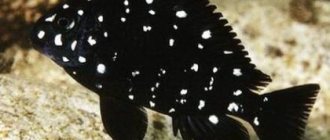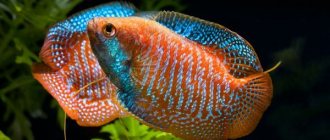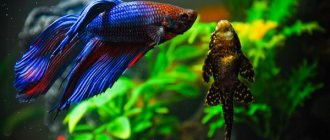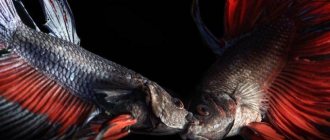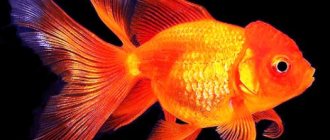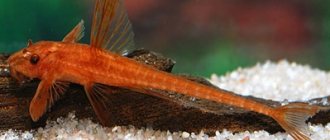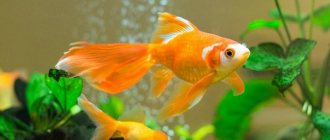4.7
(7)
Cichlids themselves, as a species of underwater fauna, are extremely interesting. They are represented in the aquarium world in a huge variety, and most of the individuals are found in Africa. Lake Tanganyika and Malawi are especially distinguished by the diversity of species. Moreover, the fish living in these reservoirs are unique and are not found anywhere else in nature.
Each type of cichlid is unique in its own way, but we will highlight one, and these are tropheus, which have a variety of colors, amazing habits and other distinctive features.
Tropheus Mura Ikola Kaiser
Description
Adult individuals reach a length of about 14 cm. Sexual dimorphism is weakly expressed, distinguishing a male from a female is problematic.
There are about 50 subspecies of the Blunt Snout Cichlid, each of which has its own original coloring and body pattern. The feeding habits determined the structure of the mouth of this fish. It is located low, the lips have acquired hard edges, making it possible to scrape vegetation from stones. You should avoid keeping several subspecies together in one aquarium in order to avoid the appearance of hybrid offspring, which often acquire a completely nondescript color.
Brief information:
- Aquarium volume - from 100 liters.
- Temperature - 23–27°C
- pH value – 8.0–9.5
- Water hardness - medium to high hardness (10–25 dGH)
- Substrate type - sand
- Lighting - moderate
- Brackish water - no
- Water movement - weak, moderate
- The size of the fish is about 14 cm.
- Nutrition - any with vegetable and protein supplements
- Temperament - conditionally peaceful towards other species, but aggressive towards relatives
- Keeping alone in a small aquarium
Notes
Like others in the genus, Tropheus duboisi is something of an enigma in the aquarium hobby and, despite its popularity, is not a suitable species for beginners. There have been many arguments and discussions about how best to keep it in an aquarium, and some of these debates are still ongoing. The generally accepted method for keeping these fish is presented here, but the reality is that what works for one aquarist may not work for another. One aspect that always holds true is that water quality is of utmost importance in a Tropheus aquarium as they are very susceptible to bloat.
The juveniles of this species look stunning, with a pattern of white or light blue spots on a black body. This coloration fades to blue-black with a yellow or white vertical stripe on the body when the fish becomes sexually mature. There are several geographical morphs* of Tropheus duboisi. Obviously they should not be mixed in aquariums as they will hybridize freely.
*Morph is a biological designation for a population or subpopulation of the same species that differ from each other in, among other things, phenotypes.
Maintenance and care, arrangement of the aquarium
The optimal aquarium size for one fish starts from 100 liters. The design is quite simple, a sandy substrate and several large stones, rocks from which caves, grottoes or any other decorative elements are built. There is no need for plants. Particular attention should be paid to the quality and composition of water. Fish need very clean and oxygen-rich water with high pH and hardness values. Along with weekly replacement of part of the water (15–20% of the volume) with fresh water, a mandatory condition is the presence of a productive filtration system, preferably with filter materials that maintain the required hydrochemical composition of the water.
Behavior and Compatibility
This species has a reputation as a very aggressive fish, but this is not entirely true. Such behavior manifests itself exclusively in relation to their relatives, who arrange deadly fights for dominance. Tropheus Mura is quite friendly to other species and can be successfully kept in company with many popular fish that can live in similar conditions. A blunt-nosed cichlid can be kept alone in a small aquarium, or in a group of at least 15–20 individuals, but in a very large tank of 1000 liters or more, which will allow each fish to find its own territory, thereby reducing the degree of aggression.
Habitat in nature
The species was first described in 1959. This is an endemic species that lives in Lake Tanganyika, Africa.
It is most common in the northern part of the lake, where it is found in rocky areas, collecting algae and microorganisms from the rocks, and hiding in shelters.
Unlike other tropheus, which live in schools, they live in pairs or alone, and are found at depths from 3 to 15 meters.
Breeding/reproduction
To breed Tropheus, you will need to solve two problems that are usually impossible for amateur aquarists to implement due to financial considerations. First, install a huge tank of 1000 liters or more with a sufficient number of shelters. Second, purchase a group of 20–30 young fish that will grow together and, as they grow older, create a community with an internal hierarchy. However, many subdominant males will die in the process. Usually there is only one alpha male left to participate in the spawning; the remaining males, if they survive, will stay away. The fish spawn in open water, the female releases several eggs (from 5 to 15) and immediately picks them up in her mouth before they fall to the bottom. Then it swims up to the male and swallows a portion of the seed, thus fertilization occurs in the mouth. For 4 weeks, the eggs and hatched fry are in the female’s mouth before they set off for free swimming. All this time she does not eat, and can noticeably lose weight. If before spawning the supply of food was not regular or the diet was poor, then the female will most likely release the fry earlier, in the worst case, she will eat them. As for the male, he does not participate in the protection and care of the offspring.
Tropheus Duboisi or Tropheus Dubois star-shaped (Tropheus duboisi)
Tropheus duboisi or Tropheus dubois (Tropheus duboisi) is a popular fish due to the very color of its young fish. But as they grow older, young individuals will change color, and when they reach puberty, they will be distinguished by their beauty.
And watching with your own eyes how the juveniles change their color is truly a pleasure, especially taking into account the fact that adult individuals will differ radically in their color. Young Tropheus Duubois have a dark body with blue spots on it, for which they are often called star-shaped.
But already adult individuals have a blue head, like a dark body, with a wide, yellow stripe running along it. But it is the stripe that may differ in color, taking into account the habitat of the fish. The stripe can be wide or narrower, white or yellow.
Star-shaped Dubois trophies became a hit among aquarists when they appeared in the world at an exhibition in Germany in the 70s of the last century and are still very popular, despite the fact that these are quite expensive cichlids, and their maintenance requires compliance with special conditions, which will be discussed speech further.
Habitat
Tropheus Duboisi was first described by naturalists in 1959, its natural habitat is Lake Tanganyika, Africa. The northern part of this lake is especially inhabited, where the fish are found in rocky places - this is both a feeding place for microorganisms and a place of shelter. A distinctive feature of the fish is that they live in pairs or alone, while other tropheus live in schools, living at a depth of 3-15 meters.
Description
The fish has a body structure that is typical for the African species of cichlids - not too dense and not tall with a fairly large head. The average size of an adult is 12 cm, although larger ones are also found in natural conditions. The body color of young individuals differs significantly from that of sexually mature adults.
Feeding
Speaking of nutrition, these fish are omnivores, although in their natural habitat they feed on algae, picking them off on the rocks. The diet also includes all kinds of phyto, as well as zooplankton. When kept in artificial reservoirs, feeding is mainly focused on plant foods, for example for cichlids. The main thing is that the food is characterized by a high fiber content, or contains spirulina. You can also feed with small pieces of vegetables, the same lettuce leaves or fresh cucumber, zucchini.
Regarding feeding with live foods, they are used as a supplement to plant foods. You can choose daphnia or artemia. You should refuse food such as bloodworms or tubifex - they should not be given, as they lead to problems with the gastrointestinal tract in fish.
The main rule in feeding Duboisi tropheus is not to overfeed, since fish have a long digestive tract, and an excess of feed leads to a malfunction of the gastrointestinal tract. It is optimal to feed little by little, 2-3 times a day.
Content
Due to the aggressive nature of the fish, it is recommended to keep them in an aquarium with a volume of at least 200 liters, in schools of 6 or more individuals. The flock should have one male and the rest females. If there are 2 or more males, the aquarium must have a larger capacity, with obligatory shelters in its design.
The soil is optimal if it is sand, the light is bright, which will enhance the growth of plants on the stones. Snags and stones, coconuts and sandstones - there should be a lot of such decor, since the fish need shelter.
When it comes to the question of which plants to choose, it is not difficult to understand that the star-shaped Dubois tropheus serve as a food source, although you can also plant several tough species, for example, by planting anubias. The water should be clean, with a minimum content of ammonia and nitrates, and a high level of oxygen.
It is important to equip the aquarium with a powerful filter, do at least 20-25% water changes every week, and a soil siphon is also required. If we talk about large-volume water changes in the aquarium, the fish tolerate them quite poorly, so it should be done strictly in parts. Ph level: 8.5 - 9.0, 10 - 12 dH. temperature indicators are 24 - 28 degrees.
Compatibility
Due to their aggressive nature, Tropheus Duboisi or Tropheus Dubois stellata is not suitable for keeping in a common reservoir, because compatibility with other peaceful inhabitants of the aquarium is low. It is better to keep them in a separate aquarium or with other cichlids. Star cichlids are less aggressive than other tropheus, although much is determined by the character of each individual.
It is recommended to keep them in flocks of 6–10 individuals, led by one male. We decided to introduce two males into the aquarium - it is worth choosing a larger capacity and arranging decorative shelters inside.
It is important to exercise maximum caution when introducing new fish, as this can lead to aggressive attacks and death of newcomers. Star-shaped Dubois trophies coexist peacefully with catfish, but keeping them with fast fish does not get along well, splashing out aggression on their relatives.
Sex differences
It is quite difficult to distinguish between a female and a male, but if you look closely, the males are somewhat larger, although this is not always noticeable. Plus, females grow more slowly, and their color is not as bright as that of the male. But, in general, females and males are quite similar to each other.
Breeding
These fish are classified as spawning fish and for the most part reproduce where they are kept, in the same aquarium. The male is in charge of arranging the nest - he digs a hole in the ground and the female lays eggs there, immediately taking them into her mouth. Next, the male fertilizes it and the eggs themselves are hatched until the fry themselves swim.
The period is about 4 weeks, during which the female will hide in shelters. During the entire period of bearing the fry, the female will feed, but in such a way that she will definitely not swallow the fry. Since the fry are born large, they can immediately be fed flakes with spirulina and brine shrimp. Many inhabitants do not touch the fry, but since the female can only bear so many fry, up to 30, it is best to place them in a separate aquarium.
Fish diseases
The main cause of most diseases of cichlids from Lake Tanganyika is unsuitable housing conditions and poor quality food, which often leads to a disease such as African bloat. If the first symptoms are detected, you should check the water parameters and the presence of high concentrations of hazardous substances (ammonia, nitrites, nitrates, etc.), if necessary, bring all indicators back to normal and only then begin treatment. Read more about symptoms and treatment methods in the section “Diseases of aquarium fish”.
Feeding
Omnivores, but in nature tropheus mainly feed on algae, which they pick off from rocks, and various phyto and zooplankton.
In the aquarium, they should be fed mainly plant foods, such as special foods for African cichlids with a high fiber content or foods with spirulina. You can also give pieces of vegetables, such as lettuce, cucumber, zucchini.
Live foods should be given in addition to plant foods, such as brine shrimp, gammarus, and daphnia. It is better to avoid bloodworms and tubifex, as they cause problems with the gastrointestinal tract in fish.
Tropheus starfish have a long food tract and should not be overfed as this will lead to problems. It is better to feed small portions two to three times a day.
